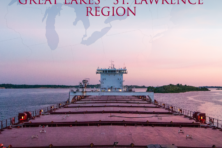By the Numbers: The Great Lakes
- Share
- Tweet
- Pin
- Share

21
The percentage of the Earth’s water contained in the Great Lakes.
84
Percentage of America’s surface freshwater contained in the Great Lakes.
151
The number of permits in the Great Lakes basin that allow discharge of combined sewer overflows into the lakes. A combined sewer system collects rainwater, runoff, domestic sewage and industrial waste into one pipe. Illinois has 42 permits, all in the Chicago metropolitan area. Wisconsin has two – one in Milwaukee for Lake Michigan and one in Superior for Lake Superior.
180
The approximate number of non-native species that have entered the Great Lakes. The EPA estimates that 30 percent of invasive species entered the lakes through the ballast water of ocean-going ships.
362
The number of contaminants that have been identified in the Great Lakes system. Only about a third of them have been evaluated for their effects on wildlife and human health.
2004
The year various agencies began work on a permanent barrier to prevent Asian carp from entering Lake Michigan.
11,000
The number of miles of shoreline and harbor around the Great Lakes.
200,000
The square miles of land that drain into the lakes.
530,000
The number of acres of coastal wetland surrounding the Great Lakes, including the world’s largest freshwater delta in Lake St. Clair.
35 million
The number of people who live within the Great Lakes in Canada and the United States.
$18 billion
The annual economic activity generated by fishing, hunting and wildlife watching in the eight Great Lakes states.
$20 billion
The amount the Great Lakes Regional Collaboration recommended for major restoration of the Great Lakes in a five-year time period, resulting in $80 to $100 billion in short- and long-term economic benefits. However, the study warned, to be effective, restoration efforts must take into account climate change.
$35 billion
The annual economic activity generated by recreational boating in the eight Great Lakes states.
Source: National Wildlife Federation, epa.gov

